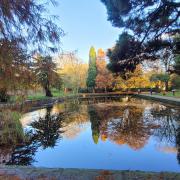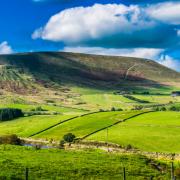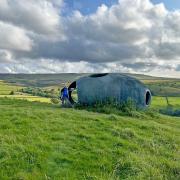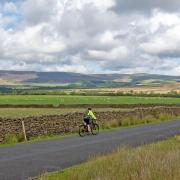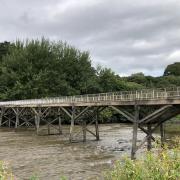Keith Carter misses a water rail but sees the chance for a great walk at a nature reserve near Rufford.
Mere Sands Wood Nature Reserve is one for the genuine bird watcher, not like me who has only a passing interest in all aspects of the natural world in a sort of jack of all trades way, master of none. Birds, butterflies, wild flowers, fungi, mammals, I’m interested in them all but not in a nerdish way. I have no long-range ’scope, no expensive close-up lens, no detailed statistics to add to but if somebody says “look, an orchid”, I’m there, my curiosity aroused. There will always be somebody to put a name to it but to me knowing the names of things is not vital to appreciating them.
Some tribes believe that by naming something you take something from it, robbing it of its mystery. I’m no list ticker and have no interest in collecting sightings of things in Nature and adding them to my list so that I can say I’ve seen over 200 species of birds and 40 different types of beetle. Life’s too short.
You’ll see them at Mere Sands Wood, ’scopes scanning the lakes. When I visited there was great excitement at the sighting of a secretive bird called a water rail, something like a moorhen in drag. It appeared as if making an entrance, calling for a round of applause. People said “did you see the water rail?” and you could hardly say “no, I missed it”. It would have showed a certain lack of respect somehow.
Mere Sands Wood lakes were formed from sand quarrying in the 1970s and the Lancashire Wildlife Trust turned the area into a reserve in the 1980s. They have built a visitor centre and a lot of the work is done by volunteers, a doughty breed who turn out in all weathers, proud to wear the green sweatshirt.
By starting our walk at the main car park we can check out the shop and buy a postcard of, for example, a water rail, those of us who missed it. We set off on a path signposted to the Marshall Hide, that is to the left if you stand with your back to the visitor centre. The well-made path goes through mixed woodland and a spur leads to the hide which looks out onto the lake known as The Hollow.
It might help to pick up the reserve leaflet for an overall picture of the reserve itself. Once past the turning to the hide we come to a fork where a signpost points right to Holmeswood Village and we take this direction emerging from the wood via a footbridge.
Cross a short stretch of field to the road, turn left and walk on the pavement for a few hundred yards then look for a footpath sign on the right. It’s just opposite Sandy Lane. The path takes a course across the open fields with not a sign of a hedge anywhere on what is obviously a very old track judging by the cobbles underfoot. On reaching a reed-fringed lake, turn right and follow a direct line between fields.
On meeting a bend in a lane keep forward with a slight emphasis to the left and we pass a farm with stabling where horses were being treated to a snack of carrots. Beyond the farm our way is barred by a wrought-iron gate with an intercom on the gatepost, defending the extensive building forming part of the Rufford New Hall complex, now converted into mews properties.
The right of way takes us to the left of this gate, between fences, passing along the bottom of a lawned area and bringing us to a lane. Head down this to reach the main A59 road and emerge opposite the Rufford Arms Hotel. Turn left then next right onto Croston Road and walk on the pavement to the canal bridge. Cross it and go down to the towpath, turning left on it, that is with the water on your right.
This is the seven-mile Rufford Branch of the Leeds-Liverpool Canal opened in 1781 to improve the facilities for transporting Wigan’s coal. It joins with the River Douglas at Tarleton lock and connects to the Lancaster Canal via the Ribble Link. Along the towpath we pass the Town Meadow Swing Bridge which my man Jim helped a lady to operate by exerting his powerful muscles. Actually the lady did most of the work, much more used to opening and closing locks than Jim. The skipper asked where we were from and on being told Goosnargh declared that he was himself from that same village, one of those occasions when somebody inevitably says “it’s a small world!” There followed a conversation naming local worthies but sadly they had none of them in common and it petered out.
We pass beside Rufford Old Hall the former home of the Hesketh family, now in the care of the National Trust. Scholars have surmised that Shakespeare stayed here as a young man and acted in plays in the Great Hall but in spite of the hundreds of books about Shakespeare’s life, hardly anything about him is known for certain.
On reaching Rufford Bridge we leave the canal and turn right past St Mary’s Church then turn left onto Liverpool Road to where the Hesketh Arms stands, a hostelry not to be by-passed without serious thought. Turn right at the pub onto Holmeswood Road then take a left onto Brick Kiln Lane and walk down as far as a bridge crossing an irrigation ditch. Turn right and take the boardwalk built into the bank then cross a lane to the cricket field, the path skirting the boundary to the left. At the wood, turn right into the reserve and follow the clear path through the trees back to the car park.
Compass points
Area of walk: Rufford and Mere Sands Wood
Distance: Approx 4 miles
Time to allow: 2 hours
Map: OS Explorer 285 Southport and Chorley
Refreshments: Hesketh Arms Rufford or Rufford Arms on A59
Possible visit: Rufford Old Hall (closed Thurs/Fri)
Not suitable for wheelchair or pushchairs
















